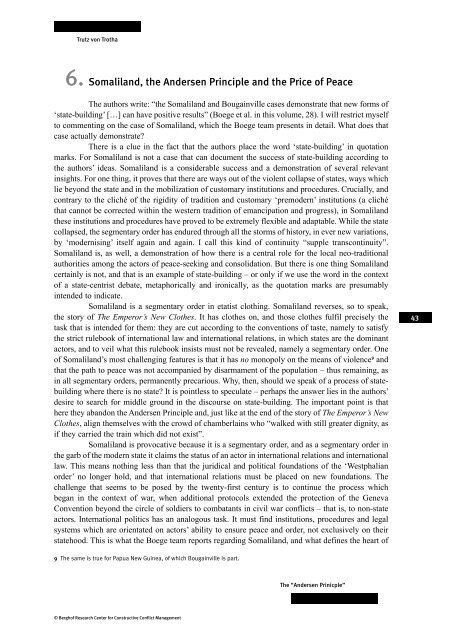Andersen Principle - Berghof Handbook for Conflict Transformation
Andersen Principle - Berghof Handbook for Conflict Transformation
Andersen Principle - Berghof Handbook for Conflict Transformation
You also want an ePaper? Increase the reach of your titles
YUMPU automatically turns print PDFs into web optimized ePapers that Google loves.
Trutz von Trotha<br />
6. Somaliland, the <strong>Andersen</strong> <strong>Principle</strong> and the Price of Peace<br />
The authors write: “the Somaliland and Bougainville cases demonstrate that new <strong>for</strong>ms of<br />
‘state-building’ […] can have positive results” (Boege et al. in this volume, 28). I will restrict myself<br />
to commenting on the case of Somaliland, which the Boege team presents in detail. What does that<br />
case actually demonstrate?<br />
There is a clue in the fact that the authors place the word ‘state-building’ in quotation<br />
marks. For Somaliland is not a case that can document the success of state-building according to<br />
the authors’ ideas. Somaliland is a considerable success and a demonstration of several relevant<br />
insights. For one thing, it proves that there are ways out of the violent collapse of states, ways which<br />
lie beyond the state and in the mobilization of customary institutions and procedures. Crucially, and<br />
contrary to the cliché of the rigidity of tradition and customary ‘premodern’ institutions (a cliché<br />
that cannot be corrected within the western tradition of emancipation and progress), in Somaliland<br />
these institutions and procedures have proved to be extremely flexible and adaptable. While the state<br />
collapsed, the segmentary order has endured through all the storms of history, in ever new variations,<br />
by ‘modernising’ itself again and again. I call this kind of continuity “supple transcontinuity”.<br />
Somaliland is, as well, a demonstration of how there is a central role <strong>for</strong> the local neo-traditional<br />
authorities among the actors of peace-seeking and consolidation. But there is one thing Somaliland<br />
certainly is not, and that is an example of state-building – or only if we use the word in the context<br />
of a state-centrist debate, metaphorically and ironically, as the quotation marks are presumably<br />
intended to indicate.<br />
Somaliland is a segmentary order in etatist clothing. Somaliland reverses, so to speak,<br />
the story of The Emperor’s New Clothes. It has clothes on, and those clothes fulfil precisely the<br />
task that is intended <strong>for</strong> them: they are cut according to the conventions of taste, namely to satisfy<br />
the strict rulebook of international law and international relations, in which states are the dominant<br />
actors, and to veil what this rulebook insists must not be revealed, namely a segmentary order. One<br />
of Somaliland’s most challenging features is that it has no monopoly on the means of violence 9 and<br />
that the path to peace was not accompanied by disarmament of the population – thus remaining, as<br />
in all segmentary orders, permanently precarious. Why, then, should we speak of a process of statebuilding<br />
where there is no state? It is pointless to speculate – perhaps the answer lies in the authors’<br />
desire to search <strong>for</strong> middle ground in the discourse on state-building. The important point is that<br />
here they abandon the <strong>Andersen</strong> <strong>Principle</strong> and, just like at the end of the story of The Emperor’s New<br />
Clothes, align themselves with the crowd of chamberlains who “walked with still greater dignity, as<br />
if they carried the train which did not exist”.<br />
Somaliland is provocative because it is a segmentary order, and as a segmentary order in<br />
the garb of the modern state it claims the status of an actor in international relations and international<br />
law. This means nothing less than that the juridical and political foundations of the ‘Westphalian<br />
order’ no longer hold, and that international relations must be placed on new foundations. The<br />
challenge that seems to be posed by the twenty-first century is to continue the process which<br />
began in the context of war, when additional protocols extended the protection of the Geneva<br />
Convention beyond the circle of soldiers to combatants in civil war conflicts – that is, to non-state<br />
actors. International politics has an analogous task. It must find institutions, procedures and legal<br />
systems which are orientated on actors’ ability to ensure peace and order, not exclusively on their<br />
statehood. This is what the Boege team reports regarding Somaliland, and what defines the heart of<br />
9 The same is true <strong>for</strong> Papua New Guinea, of which Bougainville is part.<br />
© <strong>Berghof</strong> Research Center <strong>for</strong> Constructive <strong>Conflict</strong> Management<br />
The “<strong>Andersen</strong> Prinicple”<br />
43

















